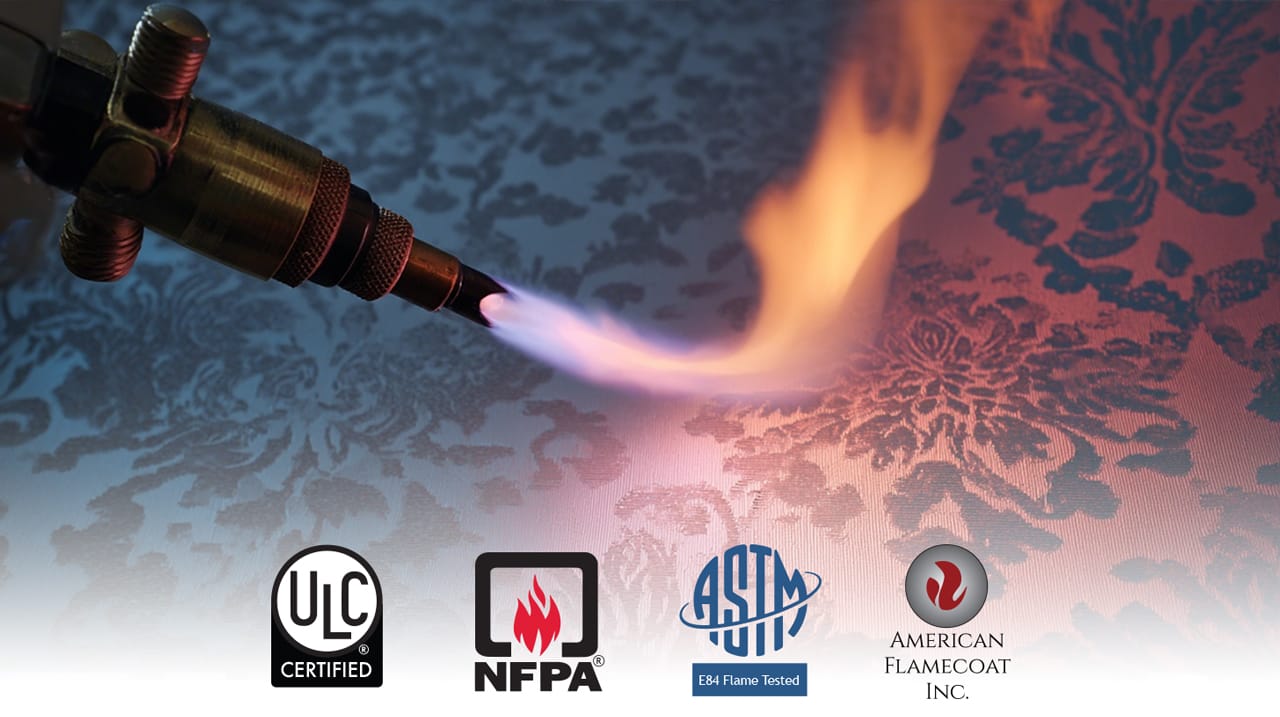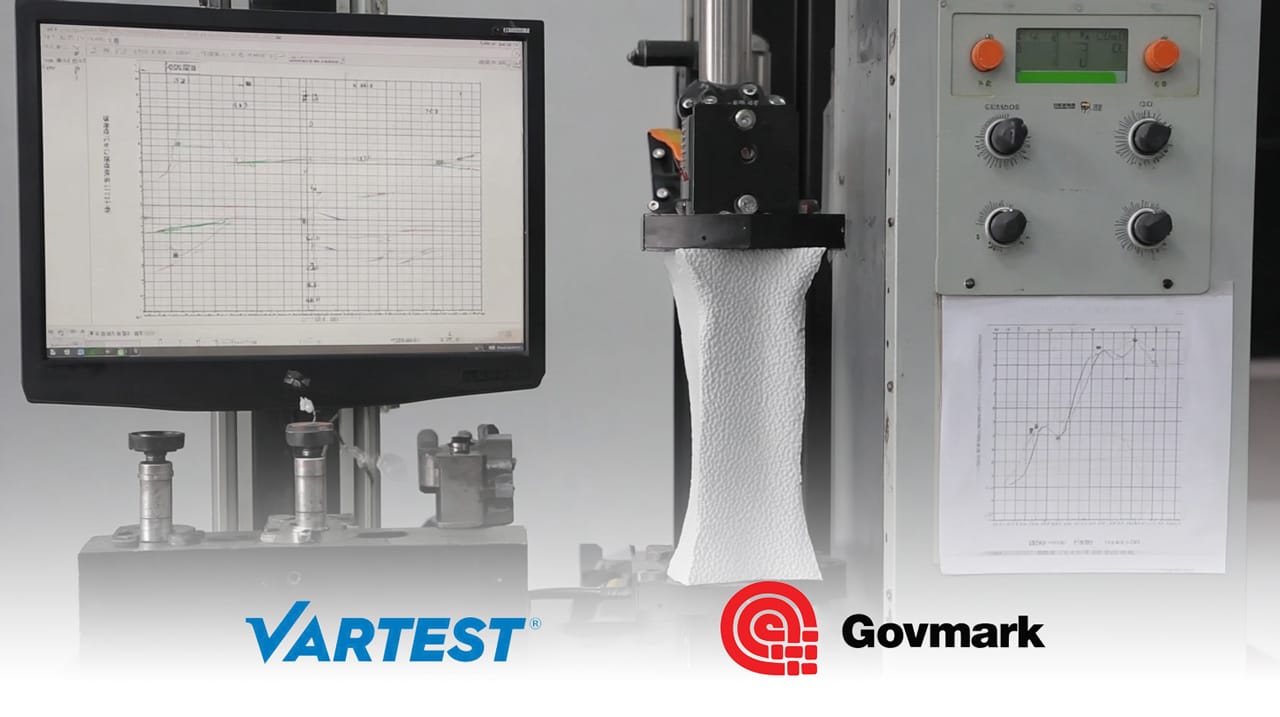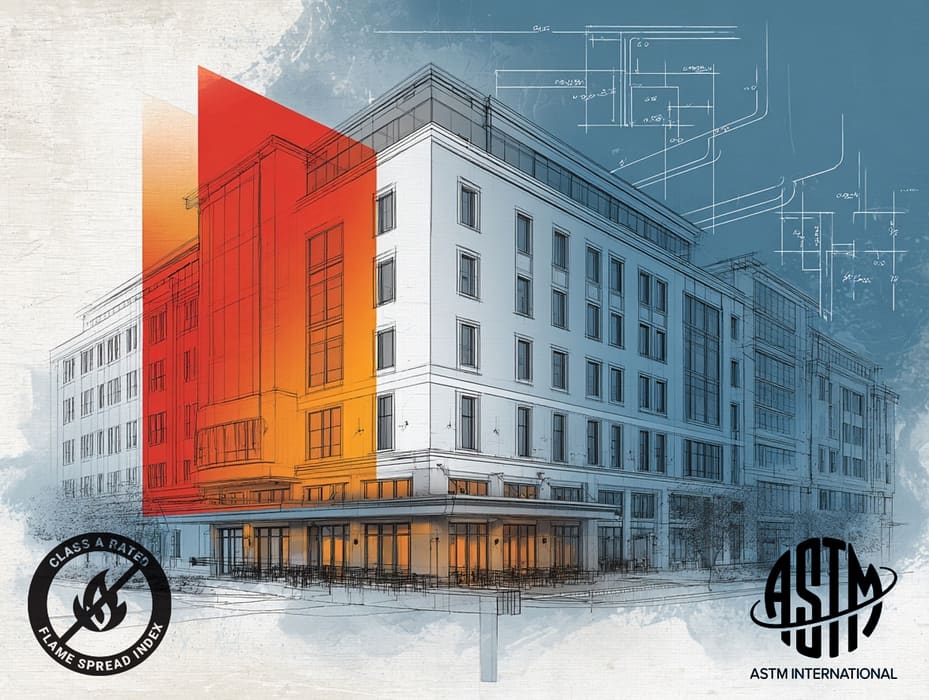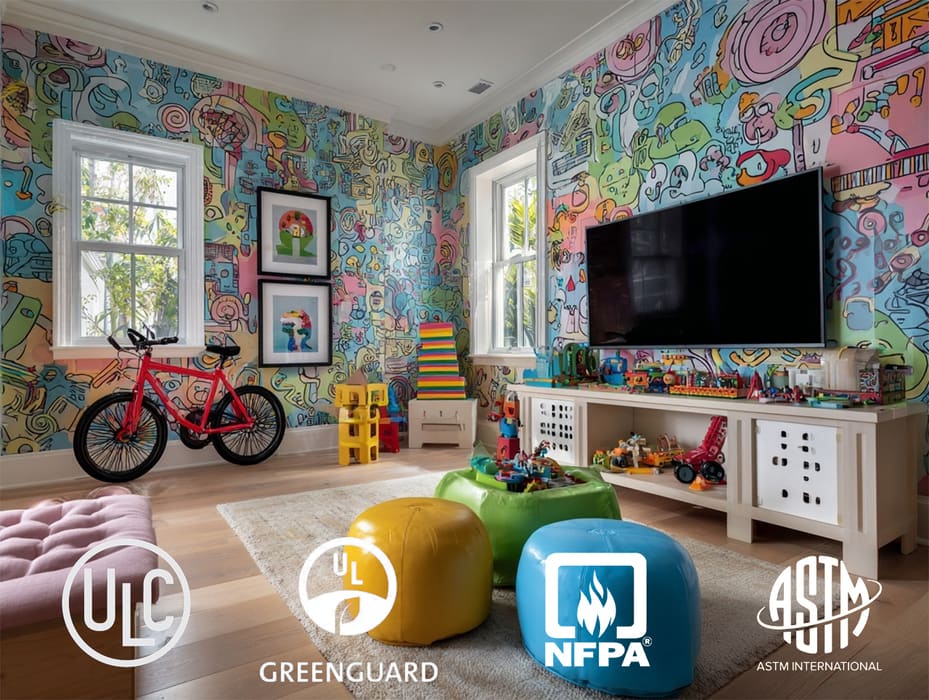Commercial Wallcovering
Technical Specs & Compliance
Your central data hub for project submittals, architectural specifications, and code compliance documentation.
This page covers the following topics:
Don't just hope your wallpaper meets building codes—prove it. Access our complete library of third-party laboratory certifications including ASTM E-84 Class A fire ratings, Low-VOC emissions testing, Type II commercial durability standards, and comprehensive material specifications.
Specify your commercial wallcovering projects with total confidence backed by documented compliance from recognized testing laboratories: Intertek, Berkeley Analytical, American Flamecoat, and more.

1. Fire Safety Ratings (ASTM & ULC)
Our wallcoverings are certified for commercial use across North America, meeting both US (ASTM E-84) and Canadian (CAN/ULC) standards. We provide full documentation for your submittal packages.
ASTM E-84 Class A (United States)
Known as the 'Steiner Tunnel Test', this is the standard for evaluating the surface burning characteristics of building materials. All our 20oz vinyls achieve a Class A rating, the highest possible.
ASTM E-84: 2-Ply 20oz Non-Woven
- Source:
- Intertek
- Date:
- April 2017
The ASTM E84 test, commonly called the Steiner Tunnel Test, measures how materials perform when exposed to fire conditions. Conducted in a 25-foot tunnel with controlled flame exposure, this test measures flame spread index and smoke development index using cement board and red oak lumber as reference standards. Building codes throughout North America recognize ASTM E84 as the standard for evaluating interior finish materials in commercial construction.
Two-ply construction with non-woven backing creates wallcovering that combines surface design flexibility with structural stability. The non-woven backing provides tear resistance and dimensional stability during installation, while the 20-ounce weight specification ensures commercial-grade durability. However, the multi-layer construction requires careful fire safety evaluation to ensure all components perform safely when exposed to flame.
This certification removes uncertainty from material specification decisions in commercial projects. Building inspectors and fire marshals recognize ASTM E84 test results as definitive proof of fire safety compliance, ensuring that wallcovering choices support smooth project approvals and meet the safety requirements essential for commercial building occupancy
 Download Test Results
Download Test ResultsASTM E-84: 2-Ply 20oz OSNA Fabric Backed
- Source:
- Intertek
- Date:
- April 2017
OSNA fabric backing technology combines the benefits of traditional fabric substrates with modern adhesive innovations. This construction method creates wallcovering with enhanced adhesion properties and improved installation characteristics while maintaining the textile-like qualities that make fabric-backed materials popular in upscale commercial applications. The 20-ounce weight ensures commercial-grade performance in demanding environments.
Fire safety testing for fabric-backed materials requires careful evaluation because textile fibers and adhesive components can behave differently than other wallcovering substrates when exposed to flame. The ASTM E84 test protocol exposes materials to controlled fire conditions and measures both flame spread rate and smoke production to ensure compliance with building code requirements for commercial interior applications.
Architects and designers can specify OSNA fabric-backed wallcoverings with confidence in their fire safety performance. This certification provides the documentation needed to satisfy building code requirements and ensures that material selections support project approvals without fire safety-related delays or complications
 Download Test Results
Download Test ResultsASTM E-84: DreamScape Nolar
- Source:
- American Flamecoat
- Date:
- November 2021
DreamScape Nolar represents advanced wallcovering technology designed for high-performance commercial applications. This material combines innovative substrate engineering with sophisticated surface treatments to create wallcovering that meets demanding aesthetic and performance requirements. The specialized construction requires rigorous fire safety testing to ensure compliance with building code requirements for commercial interior applications.
The ASTM E84 test evaluates materials under controlled fire conditions, measuring flame spread index and smoke development index against established reference standards. For advanced materials like DreamScape Nolar, this testing becomes particularly important because innovative construction methods and specialized components may behave differently than traditional wallcoverings when exposed to fire conditions.
This certification provides architects and designers with confidence that advanced wallcovering technologies can meet fire safety requirements without compromising performance or aesthetics. The documented test results eliminate uncertainty during building permit reviews and ensure that innovative material choices align with established fire safety regulations
 Download Test Results
Download Test ResultsCAN/ULC S102 (Canadian Compliance)
This standard is required for interior finishes in commercial buildings in Canada. Essential for projects north of the border.
CAN ULC Flame Test 20oz Digital
- Source:
- American Flamecoat
- Date:
- May 2013
The Canadian Underwriters' Laboratories Standard S102.2 measures how building materials perform when exposed to fire. This test specifically evaluates surface burning characteristics by exposing samples to controlled flame conditions and measuring flame spread and smoke production. Canadian building codes require this certification for interior finishes in commercial buildings, making it essential for projects north of the border.
Digital vinyl wallcovering faces unique challenges during fire testing because of its printed surface and vinyl composition. The 20-ounce weight classification indicates a heavy-duty commercial grade material designed for high-traffic environments. These tests demonstrate that despite the digital printing process and vinyl substrate, the material maintains acceptable fire safety performance.
When specifying wallcovering for Canadian commercial projects, this certification eliminates compliance uncertainty. Building officials and fire marshals recognize CAN/ULC standards as the definitive measure for interior finish safety, ensuring your project approvals move forward without material-related delays
 Download Test Results
Download Test ResultsCAN ULC Flame Test S102 3-ply Mylar
- Source:
- American Flamecoat
- Date:
- March 2018
Three-ply mylar construction represents premium wallcovering engineering, combining dimensional stability with sophisticated visual effects. The mylar layer provides metallic finishes and reflective properties that create dramatic architectural statements, while the multi-layer construction adds durability and dimensional stability. However, these complex materials require rigorous fire safety testing to ensure they meet Canadian building code requirements.
The CAN/ULC S102 standard evaluates how quickly flames spread across material surfaces and measures smoke production during combustion. For multi-layer materials like 3-ply mylar, this testing becomes particularly important because different layers may behave differently when exposed to fire. The certification confirms that all layers work together to maintain safe fire performance characteristics.
Architects specifying metallic or reflective wallcoverings in Canadian commercial projects can rely on this certification to satisfy building code requirements. The testing eliminates guesswork about how complex multi-layer materials will perform in fire safety evaluations, providing the documentation needed for smooth project approvals
 Download Test Results
Download Test ResultsCAN ULC Flame Test S102 20oz NW
- Source:
- American Flamecoat
- Date:
- March 2018
Non-woven backing material has become the preferred substrate for commercial wallcovering because of its dimensional stability and installation advantages. Unlike traditional paper backings, non-woven materials resist tearing during installation and provide better adhesion to wall surfaces. The 20-ounce weight specification indicates commercial-grade material designed for demanding applications in high-traffic areas.
Canadian fire safety regulations require all interior finishes to meet specific performance criteria under the CAN/ULC S102 standard. This test exposes materials to controlled flame conditions and measures both flame spread rate and smoke development. Non-woven backed materials can present unique challenges during fire testing because the backing material and face material may behave differently when exposed to heat and flame.
This certification provides architects and designers with confidence that their non-woven wallcovering selections will satisfy Canadian building code requirements. The documented test results eliminate uncertainty during the permit approval process and ensure that material choices align with fire safety regulations in commercial building projects.
 Download Test Results
Download Test ResultsCAN ULC Flame Test S102 20oz OSNA
- Source:
- American Flamecoat
- Date:
- March 2018
OSNA (Open Surface Non-woven Adhesive) represents advanced wallcovering technology that combines the installation benefits of non-woven materials with specialized adhesive properties. This construction method creates stronger bonds with wall surfaces while maintaining the tear resistance and dimensional stability that make non-woven materials popular in commercial applications. The 20-ounce weight classification ensures durability in high-traffic commercial environments.
Fire safety testing becomes particularly important for OSNA materials because the adhesive components and backing material create a complex substrate that may behave differently than traditional wallcoverings when exposed to flame. The CAN/ULC S102 test evaluates both flame spread characteristics and smoke development to ensure materials meet Canadian building code requirements for commercial interior applications.
Designers working on Canadian commercial projects can specify OSNA wallcoverings with confidence knowing that fire safety requirements are satisfied. This certification eliminates potential delays during building permit reviews and provides the documentation necessary to demonstrate compliance with Canadian fire safety regulations
 Download Test Results
Download Test ResultsSpecialized Fire Ratings
Additional fire safety certifications for specific applications and international markets.
ASTM E-648: Critical Radiant Flux (WallWrap)
- Source:
- Intertek
- Date:
- May 2020
The ASTM E648 test measures critical radiant flux, which evaluates how materials perform when exposed to radiant heat energy similar to conditions found in building fires. This test specifically addresses materials used in floor-adjacent wall applications where radiant heat from burning flooring materials could ignite wall coverings. The test uses a radiant heat panel to simulate these conditions and measures the minimum heat flux required to sustain flame propagation.
WallWrap Caviar represents specialized wallcovering designed for applications where radiant heat resistance becomes crucial. Areas near floor surfaces, particularly in corridors and exit pathways, face unique fire safety challenges because of potential radiant heat exposure from floor-level ignition sources. This makes ASTM E648 certification particularly valuable for materials used in these critical locations.
Building codes increasingly recognize the importance of radiant flux testing for wall materials in specific applications. This certification ensures that WallWrap Caviar meets the performance requirements for floor-adjacent installations, providing architects and designers with documentation needed to satisfy building code requirements in critical fire safety applications
 Download Test Results
Download Test ResultsEU Class Flame 13823 20oz NW
- Source:
- Exova
- Date:
- August 2013
European fire safety standards follow different testing protocols than North American systems, using EN 13823 to evaluate building product reactions to fire. This test, known as the Single Burning Item (SBI) test, exposes materials to thermal attack from a single burning source and measures heat release, flame spread, and smoke production. European building codes require this certification for interior finish materials in commercial construction projects.
Non-woven backing materials offer installation and performance advantages in commercial wallcovering applications, but their fire safety characteristics require careful evaluation under European testing standards. The 20-ounce weight specification indicates commercial-grade material designed for demanding applications, while the European certification ensures compliance with regional building code requirements.
Architects working on European projects or international developments with European building standards can specify this wallcovering with confidence in its fire safety performance. The EN 13823 certification eliminates compliance uncertainty and provides the documentation necessary to satisfy European fire safety regulations in commercial building projects
 Download Test Results
Download Test Results
2. Indoor Air Quality & Sustainability (LEED/WELL Projects)
Our materials are certified for use in sensitive environments like healthcare, education, and LEED-certified projects, supporting healthy indoor air quality.
VOC Emission Test: Fabric Backed Vinyl
- Source:
- Berkeley Analytical
- Date:
- May 2017
Volatile Organic Compounds (VOCs) are chemicals that evaporate from building materials and can impact indoor air quality. The California Department of Public Health Standard Method V1.2-2017 represents the most stringent testing protocol for measuring VOC emissions from interior finish materials. This testing evaluates both individual chemical emissions and total VOC levels to ensure materials meet indoor air quality requirements for sensitive environments.
Fabric-backed vinyl wallcovering combines the durability of vinyl surfaces with the installation benefits of textile backing materials. However, both vinyl and adhesive components can potentially emit VOCs, making emission testing crucial for applications in sensitive environments like healthcare facilities, schools, and residential spaces. The testing protocol simulates real-world conditions over extended periods to measure actual emission levels.
This certification provides architects and designers with confidence that fabric-backed vinyl wallcoverings meet indoor air quality requirements for sensitive applications. The documented low emission levels satisfy green building standards and ensure compliance with regulations governing indoor environmental quality in commercial and residential construction projects.
 Download Test Results
Download Test ResultsVOC Emission Test: Non-Woven Backed Vinyl
- Source:
- Berkeley Analytical
- Date:
- May 2017
Non-woven backed vinyl wallcovering represents the most popular commercial wallcovering construction because of its installation advantages and performance characteristics. However, both vinyl face materials and backing adhesives can potentially emit volatile organic compounds that impact indoor air quality. The California Department of Public Health testing protocol provides the most comprehensive evaluation of VOC emissions from interior finish materials.
Commercial environments like offices, retail spaces, and hospitality facilities require materials that maintain indoor air quality while providing durability and aesthetic appeal. The CDPH Standard Method V1.2-2017 testing evaluates emissions over extended periods under controlled conditions that simulate real-world building environments. This comprehensive approach ensures that test results accurately reflect actual building performance.
Architects and designers can specify non-woven backed vinyl wallcoverings with confidence in their indoor air quality performance. This certification satisfies green building requirements and provides documentation needed to meet indoor environmental quality standards in commercial construction projects where occupant health and comfort are paramount.
 Download Test Results
Download Test Results
3. Commercial-Grade Performance & Durability
Our 20oz Type II materials are engineered to withstand the demands of commercial environments. We provide objective, third-party data on performance.
Tear Strength (ASTM F-793): 20oz Non-Woven
- Source:
- Govmark
- Date:
- January 2014
Tear strength represents a critical performance characteristic for commercial wallcovering, particularly in high-traffic environments where impacts and abrasion are common. The ASTM F793 test uses an Elmendorf apparatus to measure the force required to continue a tear once started in the material. It works by initiating a small cut in the test material and then applying force to propagate the tear. This standardized testing provides quantifiable data about material durability under stress conditions that simulate real-world commercial use.
20-ounce non-woven wallcovering represents heavy-duty commercial grade material designed for demanding applications. The non-woven backing provides inherent tear resistance compared to paper-backed alternatives, while the substantial weight specification ensures durability in high-impact areas. However, quantifying this performance through standardized testing provides architects and designers with objective data for material selection decisions.
This certification eliminates guesswork about wallcovering durability in commercial applications. The documented tear strength values provide confidence that material selections will withstand the demands of high-traffic commercial environments like corridors, lobbies, and public spaces where durability directly impacts long-term project success and maintenance costs.
 Download Test Results
Download Test ResultsBreathability (ASTM E-96): Wet Cup Test
- Source:
- Vartest
- Date:
- June 2012
Moisture management in wall systems requires careful consideration of vapor transmission properties in wallcovering materials. The ASTM E96 Wet Cup Test measures how water vapor passes through materials under controlled humidity conditions. This testing becomes particularly important in environments where moisture levels fluctuate or where preventing moisture buildup behind wallcovering is crucial for long-term performance.
Breathable wallcoverings allow controlled moisture transmission that prevents condensation buildup while maintaining surface integrity. This characteristic becomes essential in applications like restaurants, healthcare facilities, and other commercial environments where humidity levels may vary significantly. The wet cup test method specifically evaluates performance under high humidity conditions that simulate challenging real-world environments.
This certification provides architects and designers with confidence that wallcovering selections will manage moisture effectively in demanding commercial applications. The documented vapor transmission properties ensure that material choices support long-term wall system performance and prevent moisture-related failures that could compromise both aesthetics and structural integrity.
 Download Test Results
Download Test Results
4. Material Transparency & Sustainability Declarations
We provide full transparency into our material composition and environmental impact through third-party verified declarations, supporting the most stringent green building and healthy interior standards.
Health Product Declaration (HPD): Vinyl Wallcovering
- Source:
- HPDC Online Builder
- Date:
- Feb 2020
A Health Product Declaration (HPD) provides a standardized, transparent report of a product's contents and their potential health hazards. This HPD covers our standard 15oz and 20oz vinyl wallcoverings (both woven and non-woven backing).
It discloses all ingredients, such as PVC, plasticizers (like DOTP), and pigments (like Titanium Dioxide), and screens them against HPD Priority Hazard Lists.
This document is essential for architects specifying for LEED v4 (MR Credit: Building Product Disclosure) and designers focused on material health and transparency. It confirms our standard vinyl products meet CA 01350 for VOC emissions.
 Download Test Results
Download Test ResultsHealth Product Declaration (HPD): Terralon Non-Vinyl
- Source:
- HPDC Online Builder
- Date:
- Feb 2020
For projects requiring a PVC-free solution, our Terralon line has its own Health Product Declaration (HPD). This document verifies its non-vinyl composition, detailing contents like Cellulose Pulp and Post-Consumer Recycled PET.
This HPD is the definitive proof for specifiers needing to meet "Red List Free" requirements or strict environmental mandates. It confirms NSF 342 Sustainability Standard certification and CDPH V1.1 (CA 01350) compliance for VOC emissions.
This is the ideal choice for the most eco-conscious projects in healthcare, education, and corporate interiors.
 Download Test Results
Download Test ResultsEnvironmental Product Declaration (EPD): UL Certified
- Source:
- UL Environment / IGI
- Date:
- Feb 2018
An Environmental Product Declaration (EPD) is an independently verified document that quantifies a product's environmental impact over its life cycle (LCA). These EPDs cover both our Non-Woven Backing and Woven Textile Backing vinyl wallcoverings.
Published by IGI (The Global Wallcoverings Association) and certified by UL Environment, these documents provide critical data for architects pursuing LEED v4 MR Credits (EPD credit).
They detail the product's entire lifecycle, from raw material supply (A1-A3) to disposal (C1-C4), and confirm compliance with standards like ASTM E 84 and CDPH (CA 01350).
 Download Test Results
Download Test ResultsRed List Compliant (Terralon)
- Source:
- Roysons Corporation
- Date:
- June 2019
This declaration confirms that our DreamScape Terralon non-vinyl wallcovering meets the Imperative 13 Red List requirements. The "Red List" identifies chemicals and compounds designated as harmful to health and the environment, such as PVC, Phthalates, and Formaldehyde.
This document lists all product components (like Cellulose Pulp and PET backing) and explicitly states that none of the Red List chemicals are present.
This certification is essential for projects striving for the Living Building Challenge and for clients in healthcare or education demanding the absolute highest standard of material safety.
 Download Test Results
Download Test ResultsFrequently Asked Questions
What is ASTM E-84 Class A fire rating for wallpaper?
ASTM E-84 Class A is the highest fire safety rating for US commercial interiors.
It requires a Flame Spread Index of 0-25 and a Smoke Developed Index of 0-450, making it compliant for high-traffic public spaces like lobbies and corridors.
Do you provide VOC emissions data for wallpaper?
Yes. Our commercial materials are tested per California CDPH V1.2-2017, the most stringent protocol.
This ensures they meet low-VOC requirements for sensitive environments like healthcare, schools and LEED-certified projects.
What certifications are needed for Canadian commercial projects?
CAN/ULC S102 is the required standard for commercial interior finishes in Canada.
We provide full test reports for our digital vinyl, non-woven, OSNA, and mylar wallcoverings to ensure compliance for your Canadian projects.
Are your wallpapers certified for Type II commercial use?
Yes. Our 20oz materials meet Type II specs, verified by ASTM F793 (Tear Strength) and ASTM E96 (Breathability) certifications.
This confirms their durability for high-traffic hospitality, retail, and corporate environments.
Can I download all certifications at once?
Yes, we provide a zipped archive containing all test results for your convenience.
 How to Choose Fire-Rated Wallpaper
How to Choose Fire-Rated Wallpaper Choosing Safe Wallpaper for Sensitive Environments
Choosing Safe Wallpaper for Sensitive Environments